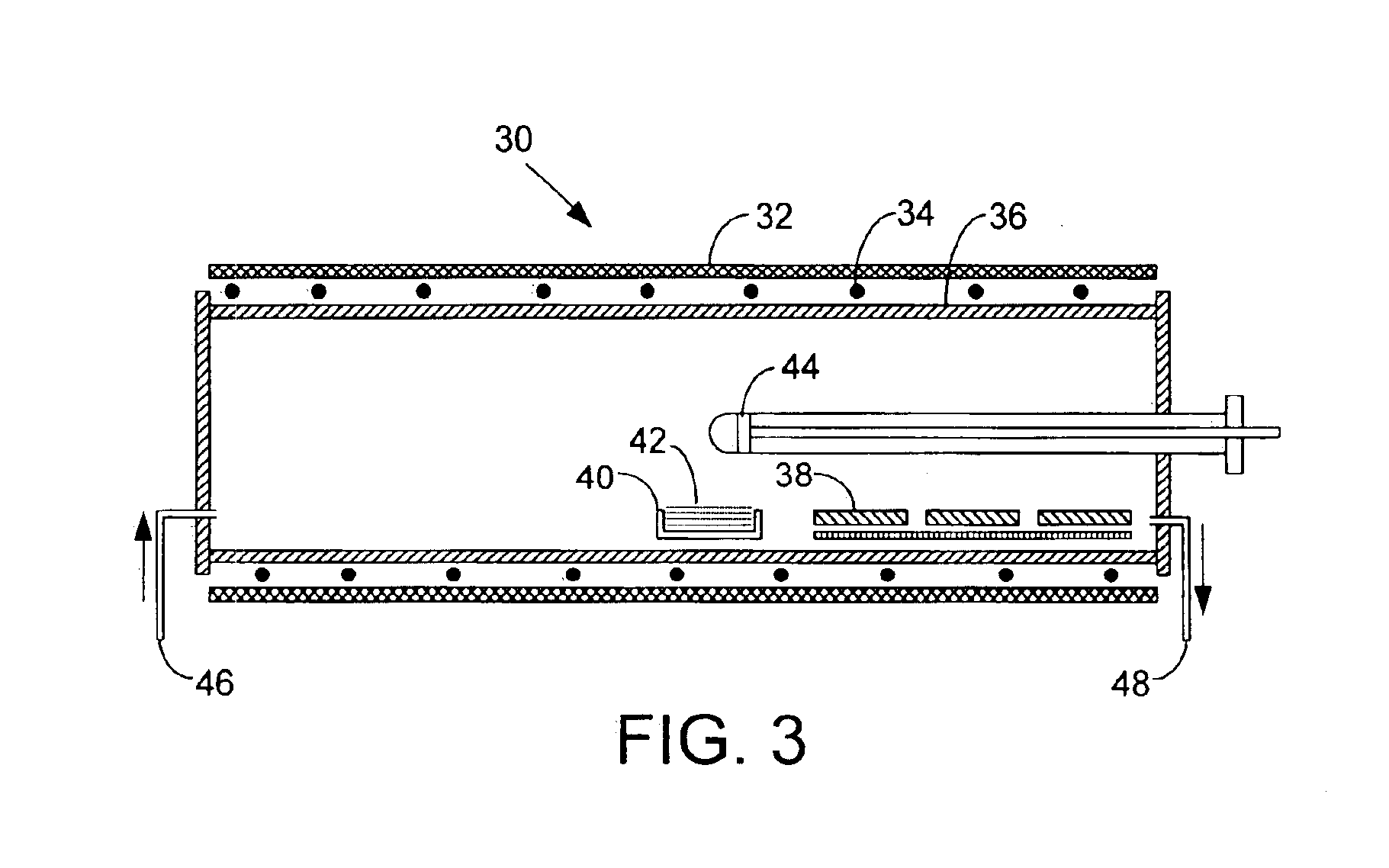Semiconducting oxide nanostructures
a technology of semiconducting oxide and nanostructure, which is applied in the field of nanostructures, can solve the problems of uncontrollable properties, difficult control of the structure and morphology of many nanostructures, and difficult investigation of wire-like semiconducting oxide nanostructures
- Summary
- Abstract
- Description
- Claims
- Application Information
AI Technical Summary
Benefits of technology
Problems solved by technology
Method used
Image
Examples
example 1a
Thermal evaporation of zinc oxide (ZnO) powders (purity: 99.99%, melting point: 1975° C.) at 1400° C. for approximately 2 hours resulted in white wool-like products that formed in high yield on the surface of the alumina plate 38. Scanning electron microscopy (SEM) observations reveal that the products consist of a large quantity of nanostructures with typical lengths in the range of several tens to several hundreds of micrometers, while some of nanostructures have lengths on the order of millimeters. EDS microanalysis and powder XRD measurement show that the sample is wurtzite (hexagonal) structured ZnO with lattice constants of a=3.249 Å and c=5.206 Å, consistent with the standard values for bulk ZnO.
TEM images reveal that the ZnO nanostructure has a substantially rectangular cross-section (i.e., nanobelt) that is distinct in cross-section from nanotubes and nanowires. Each nanobelt has a uniform width along a substantial portion of the length of the nanobelt, and the ty...
example 1b
Zinc oxide (ZnO) is a versatile “smart” material that has applications in catalysts, sensors, piezoelectric transducers, transparent conductor, and surface acoustic wave devices. The non-central symmetry and the tetrahedrally coordinated ZnO4 unit in ZnO result in anisotropic piezoelectric properties. Structurally, the wurtzite structured ZnO crystal is described schematically as a number of alternating planes composed of fourfold coordinated O2− and Zn2+ ions, stacked alternatively along the c-axis. The oppositely charged ions produce positively charged (0001)-Zn and negatively charged (000{overscore (1)})-O polar surfaces, resulting in a normal dipole moment and spontaneous polarization, as well as a divergence in surface energy. To maintain a stable structure, the polar surfaces generally have facets or exhibit massive surface reconstructions, but ZnO ±(0001) is an exception, which is atomically flat, stable, and without reconstruction.
example 1c
Zinc Oxide
Self-assembly is a fundamental approach for organizing and constructing hierarchical structures using nano-building-blocks through substrate patterning and surface functionalization. Self-assembly of nanocrystals is driven by van der Walls forces and hydrogen bonding among the passivating organic molecules on the particle surfaces. Polar-charge induced self-assembly is frequently observed for chain molecules in a solution environment: a local spontaneous ordering of molecular polarity and chirality resulting in the formation of stripes; and chiral domains of achiral molecules and ferroelectric liquid crystals being polarization-induced self-assembly. For crystalline nanomaterials grown in a solid-vapor environment, one type of polar-charge induced helical and spiral structures of ZnO has been done (see Example 1B). In this example, a distinct and unique nanoring structure that is formed by spontaneous self-coiling of a polar nanobelt during growth is described. Although no...
PUM
| Property | Measurement | Unit |
|---|---|---|
| height | aaaaa | aaaaa |
| width | aaaaa | aaaaa |
| width | aaaaa | aaaaa |
Abstract
Description
Claims
Application Information
 Login to View More
Login to View More - R&D
- Intellectual Property
- Life Sciences
- Materials
- Tech Scout
- Unparalleled Data Quality
- Higher Quality Content
- 60% Fewer Hallucinations
Browse by: Latest US Patents, China's latest patents, Technical Efficacy Thesaurus, Application Domain, Technology Topic, Popular Technical Reports.
© 2025 PatSnap. All rights reserved.Legal|Privacy policy|Modern Slavery Act Transparency Statement|Sitemap|About US| Contact US: help@patsnap.com



